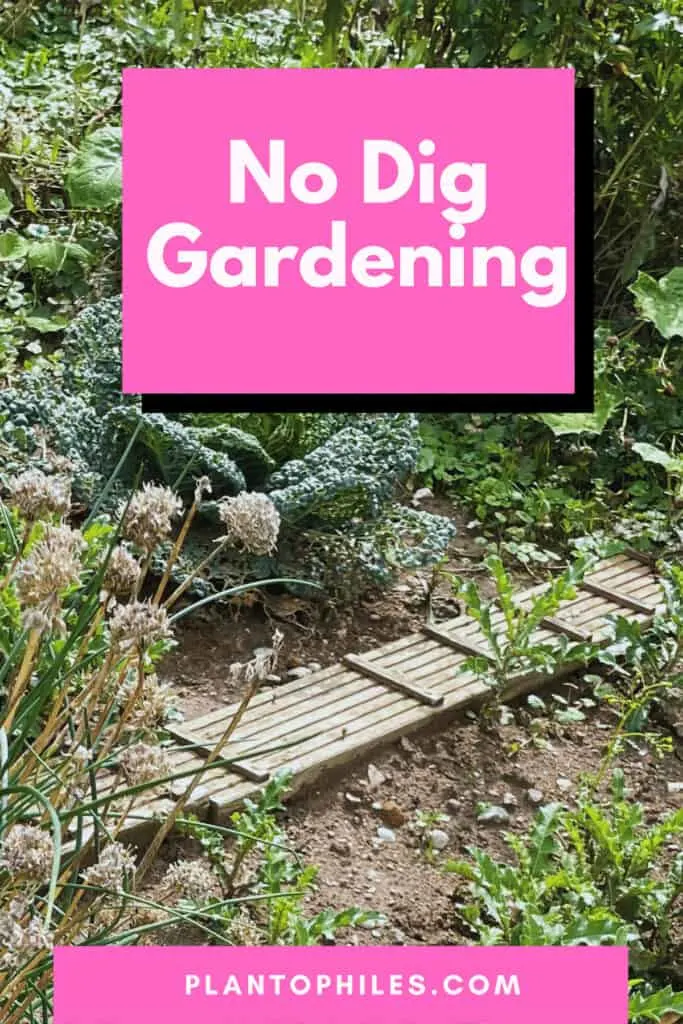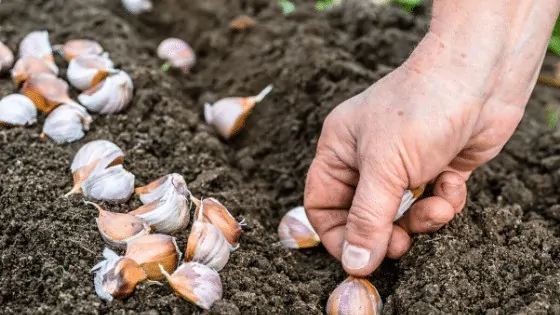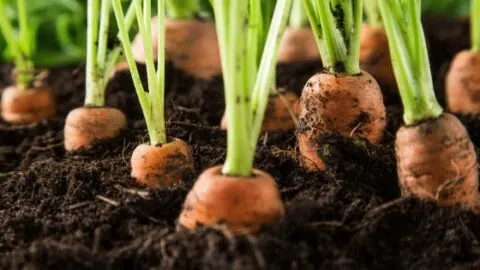You have recently heard about the trend no dig gardening but are not quite sure what it is. This article is for you as I will break this gardening technique down for you.
No Dig Gardening
No dig gardening is a trend that has its roots in the ‘not cultivating the soil too much’ concept. To the naked eye, a clump of soil may just be a mixture of organic matter that acts as a medium of plant growth.

But the soil in itself is an ecosystem featuring a complex underlying structure and is home to a diverse life.
Table of Contents
In the gardening sphere, digging is a common practice. However, we don’t realize that digging exposes the soil to air and sunlight, damaging the delicate soil structure while killing the living organisms. The result is soil compaction, leading to increased surface runoff. This age-old process is also observed to weaken soil fertility by draining away essential nutrients. The soil is also susceptible to losing organic matter causing the water retention capability to weaken.
On the contrary, the infant concept of no dig gardening is tailored to cater to the aforementioned drawbacks of soil tilling. No dig gardening keeps the soil intact with increased water retention while preventing weed growth to give a higher yield.

HOW TO GET STARTED WITH NO DIG GARDENING
A no dig garden comes with a lot of ease and is also friendly with your budget. Here is a basic guide to walk you through how to do no dig gardening:
Choosing the location
Before getting started with soil preparation, you must select and mark a suitable location for your no dig garden. The garden surface should be flat and smooth and should receive regular sunlight throughout the day.
Concerning the size, you can go as big as you want depending on the nature of your needs. However, it is suggested that you start with a small piece of garden and learn your way through a bigger one year by year.
Lastly, consider the climatic zone you live in, as it will play a pivotal role in determining the watering routine for the garden. Make sure that you have a proper irrigation system for times when rain doesn’t fall.
Add a weed barrier
Adding a biodegradable weed barrier helps in the prevention and control of weeds. These weeds can come up in the garden at any time and affect plant growth.
You can use damp newspaper sheets or cardboard as well. But ensure that the material used is thick in size, and you moist it well in a tub of water before laying it over the soil. Align the paper and overlap it to allow movement in the plantation.
Before you progress with mulching, check for any signs of gaps and fill them up. Weeds tend to find sunlight pouring through holes, and germinate in no time.
Preparing the soil
Once you have chosen the location, it’s time to prepare the ground and soil. If you are transforming an existing garden space, then you don’t require any additional preparation. However, for hard surfaces and rocky ground, you will have to first lay down branches, twigs, and dry leaves at a height of at least 4 inches.
Similarly, for a no dig garden over lawn grass, mowing the grass first is a crucial step. Next, you can add nitrogen fertilizer to allow the grass to rot down after it is buried under a layer of mulch.
Adding a layer of mulch
Mulch is commonly described as organic matter that is layered on top of the soil rather than mixing it with the soil. It helps the soil in retaining moisture while improving fertility and aeration.
For no dig gardening, you will have to spread 5 inches of mulch over the soil. You can also use a combination of mulch and straw to facilitate the process of breaking down.
Adding a layer of nitrogen-rich fertilizer
A nitrogen-rich fertilizer is the next essential to help you prepare your no dig garden. You can also add fresh materials like chicken manure, green weeds, and grass clippings as they have nitrogen content as well. And then regularly water the soil with a water hose.
Planting Seeds
To start the planting activity, pull back some mulch and make small pockets, and add some compost. These holes can be approximately 4 inches wide as well as 4 inches deep. You can then plant seeds or seedlings as per your liking.
You must plant a diverse range of seasonal vegetables and flowers. And then, follow the plant care guide as per the seed you have planted. Make sure that you water each pocket individually and regularly check if the seeds are firm. Seaweed extract may also be added when watering the no dig garden, as seaweed is home to rich minerals that help in the development of plant growth with strong roots.
MAINTAINING A NO DIG GARDEN
- The trick to maintain a no dig garden is fairly easy. You have to add new material to the garden just when the previous year’s plantation has been harvested completely, and the soil surface has started to show signs of rotting. This is typically at the start of spring and autumn.
- Keep track of the following steps to help the layers of your no-dig garden to replenish:
- Avoid over-watering. Before you water, it is better to feel the mulch and check if it needs water. Drowning the soil in water will affect root growth.
- Make sure you pull out any weeds as soon as you see them emerge to stop them from spreading all over the no dig garden.
- Prepare additional compost while your garden is growing.
- Once you remove any plant, fill in the hole with a handful of compost and place another plant.
- As soon as the next growing season, get ready with a new layer of mulch for the soil. But before you spread it over, check how much is needed by the garden. Fork the soil at different places to see if it is loose; you can add a layer of newspaper for a weed barrier.
- Crop rotation is a vital practice that keeps the soil healthy. It prevents soil depletion while maintaining soil fertility.
Problems with No Dig Gardening
- no dig gardening sets a mandatory usage of mulch and compost. If you can produce the two on an industrial scale, with large quantities, then only you’ll master no dig gardening and attain successful results for a large garden.
- For seriously compacted soil conditions, immediate start to no dig gardening is a big struggle. You may have to till the soil once or twice, disrupting the soil structure.
- no dig gardens require reserved pathways for people to walk. No animals or human beings are allowed to walk on soil beds associated with a no dig garden territory. Construing such pathways may be difficult for certain garden plots due to location issues. You may consider raised beds to tackle the issue, but they won’t be a viable solution for long.
- To keep the soil moist, healthy, and active with weed-fighting capabilities, large amounts of mulch is required.
- In areas with wet climatic conditions, you will have to check the type of mulch before formally using it on the soil bed. The reason being, slug formation on a stable garden bed as the mulch decomposes. Slugs don’t occur in areas with dry weather conditions.
FAQ
Why is no dig gardening important?
Unlike normal gardens, no-dig gardens do not allow stepping on the soil, which is why a separate path is reserved for people to walk on. Walking on the soil disrupts the natural soil structure causing compaction and halting nutrient penetration to the roots. This disturbed flow of water and essential nutrients affects plant growth while reducing productivity.
How to convert an existing garden to a no dig garden?
Renovating an existing garden is a common practice since new building gardens from scratch is a time-consuming process. A two-layer mulch has to be spread to transform your fully planted garden as a no dig garden.
Initially, you will have to loosen the compact soil. This can easily be done with a garden fork and then adding organic matter, allowing the natural organisms to do the digging naturally.
After the soil has loosened well, layer it with manure and compost.
The last step is to layer the soil with straw at the height of 10 inches over the manure and compost.
Why does no dig gardening control weed growth?
By digging the soil, we disturb the soil structure. This disturbance accelerates the germination of weeds. However, with no dog gardening, the extra layers of mulch cover the entire garden, and thus weeds weaken and die.
When does the no dig garden needs re-mulching?
As soon as you observe the previous year’s mulch fading away and the soil starts to appear bare, the no dig garden needs re-mulching. Even if you see small pockets of bare soil, it is recommended that you resume the mulching process. Mostly, this is done after the harvesting season comes to an end in spring and autumn.
Is no dig gardening a natural and environment-friendly process?
The no dig garden is observed as a natural practice that allows you to be kind to the environment. You keep the carbon intact in the soil. By allowing earthworms to facilitate the natural process of digging, the chances of erosion are less likely. The soil remains stable, holds enough moisture, and essential minerals and nutrients don’t drain away.
Is no dig gardening more difficult when compared to other gardening methods?
The no dig garden is lightly slow-paced and takes time to establish well. However, if you learn to manage the perennial weeds through mulching, this method wins over other conventional methods of gardening. No-digging is commonly practised in winters, and in summers for weed control, this makes it time-efficient and easy.
Does no dig gardening make it more difficult to incorporate manures?
In no-dig gardening, manure is not incorporated with the soil, instead, it is layered up over the soil. Organisms in the soil extract nutrients from the organic matter lying on the surface, this makes mulching a beneficial and productive process.
What to plant in no dig gardens?
Under different weather conditions, no-dig gardens favor the growth of a wide range of vegetables and flowers.
In areas with moderate rainfall, the following vegetables are most likely to grow successfully:
- Onions
- Chives
- Horseradish
- Garlic
- Pumpkins
- Broccoli
- Parsley
- Carrots
- Beetroots
- Zucchini
- Kohlrabi
- Leaf parsley
- Broccoli
- Beets
- Dill
Can we have trouble with mulch?
If you mulch the soil with undecayed and fresh organic matter (fresh grass, leaves, manure, hay), then it will be home to creatures like slugs and snails. It may also give rise to bigger animals causing gardening issues. Try to avoid using fresh mulch in garden beds that already have slugs. Instead, use old rotten manure, rotten hay, and grass clippings.
What are the basic guidelines for beginners trying no dig gardening?
For beginners, the most important step is to gather material for healthy mulching. Black polyethylene serves as a good weed-controlling material.
The next thing to keep in mind is compost. Find a budget-friendly source of compost, either get it from local compost-makers or make your own at home using animal mature. Mulch compost will ease the weeding process for you. Lastly, it is better that you start with a small soil bed for no dig gardening.
A no dig garden is the perfect go-to for having your own freshly grown vegetables. The soil is lively and healthy; thus, the product is rich in nutrients and tastes delicious.
Keep your gardening routine simple, productive, and speedy by transitioning from conventional digging to no dig gardening. Fertile soil helps the healthy growth of vegetables while providing pest control. The organic matter decomposes and transforms into rich compost, giving beneficial nutrients to the plant roots.
This way of gardening is more than just a mere trend but a healthy way of gardening that is here to stay. What holds you back from trying it on your own? Get into no dig gardening now.
Dig it?
So no-dig gardening is the concept of leaving and enriching the soil as is with as little external intervention and disturbance as possible.

Daniel has been a plant enthusiast for over 20 years. He owns hundreds of houseplants and prepares for the chili growing seasons yearly with great anticipation. His favorite plants are plant species in the Araceae family, such as Monstera, Philodendron, and Anthurium. He also loves gardening and is growing hot peppers, tomatoes, and many more vegetables.


